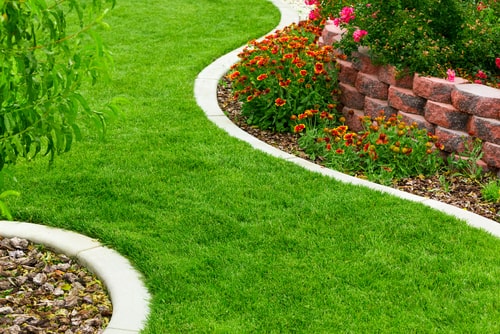The grass might be greener on the other side, but is it as ‘edgy’ as yours?
Lawn edging is a great way to take your landscape to the next level while also functionally caring for your garden.
Read on to find out how lawn edging, also known as landscape edging, can benefit your home or business.
What Exactly is Landscape Edging?
As you may have guessed, garden bed edging is a way to create clean lines along the boundary, or edge, of your garden.
Depending on your goal and aesthetics, you can choose from a number of materials to create garden edging, including blocks, metal, timber or even concrete. These keep your plants and flower beds nice and tidy by defining your garden’s borders.
If you’re stuck, check out our blog post on four of the landscape edging styles we recommend to transform your backyard.
Why Is Lawn Edging Important?
Garden edging can improve the look of your garden by defining flower beds, shrub beds, pathways or a single tree, improving the overall design of your garden.
It can also benefit your garden in a more functional way too. Most notably, lawn edging can be used to keep grass runners from making their way into your garden or flower beds, keep the soil where you want it, make garden maintenance much easier and stop people from walking through your garden. (Also read: 4 Landscape Edging Styles to Transform Your Backyard)
Keep Lawn Runners Out
How often do you have to pull those annoying weeds AND grass out of your garden beds? Especially in winter, it feels like your grass might take over the entire backyard with how fast it grows!
Garden edging creates a barrier within the soil to help prevent roots from invading your garden beds, saving you time and effort while also giving your garden a manicured appearance.
Keep the Soil In
Lawn edging also helps to prevent soil and mulch from washing out from your garden beds and onto your lawn during winter rain.
Preventing soil erosion is key to vital to the health of your plants and trees, especially if you’ve recently added mulch or fresh soil to the garden.
Make Maintenance Easier
Lawn mowing, edging turf, fertiliser application and irrigation are all made easier with the installation of landscape edging, as it creates an obvious barrier between the sections of your garden and clean, crisp lines for you to follow along
Define Pathways Through Your Garden
Sick of visitors, tradies or even your own family trampling your much-loved garden? Landscape edging can help to define clear access routes through your garden, helping to prevent accidental trampling of plants.
Landscape Edging: Installation and Materials
The style of your yard and the goal of your landscape edging will help to determine which type of edging you need – you can use plastic, stone, corrugated steel, limestone, treated pine or even concrete. The most common materials used in landscape edging and other forms of hardscaping are blocks and metal.
The installation method for your landscape edging will depend on the material you choose. For steel garden ending, common installation methods are as follows:
- Laying materials on the ground to create a border – this method suits limestone blocks for use around your garden, rather than lawn
- Digging a trench
- Installing stakes to hold the edging in
- Hammering the landscape edging directly into the soil
Contact our team to learn more about edging installation.
Get Your Garden Looking Good with Lawn Edging
Give your curb appeal the edge with landscape edging installed by Looking Good Landscaping.
We’ve been transforming gardens and yards in the Perth metro area for over two decades, fuelled by our passion to create spaces that ‘look good’ and reflect your personal style.
If you’re looking for a stylish, yet functional way to improve your garden, contact us today to discuss how garden edging solutions can make all the difference.







